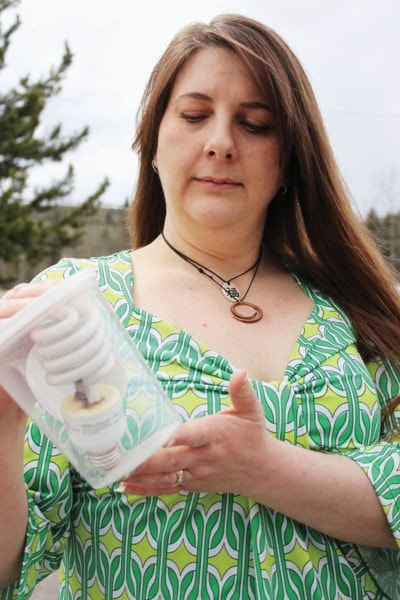Kerri Mingo says that around 11 p.m. on May 1, her husband, Dave, put their dog out before everyone went to bed, and what happened next was somewhat unnerving.
When Dave and the dog came back into the mudroom, it was dark, as the light was no longer on. He flicked the switch but the light didn't go on.
Surprised, Dave flicked on the light in the adjoining hallway, turned around and saw the mudroom was full of smoke, which was starting to drift into the hallway.
Kerri says the mudroom compact fluorescent light (CFL) bulb was spewing a greyish, brown and black smoke.
"He immediately tried to remove the light from the socket, but it was too hot for him to touch."
Then they opened all the doors and windows and tried to get the smoke out of their house, she says, adding the smoke had completely filled their home.
Noting it smelled like burned plastic, Kerri says it was like breathing in smoke and it was difficult to breathe.
She adds Dave didn't to appear to have any difficulties other than breathing problems initially. However, Kerri notes her eyes burned the next day like she would get from the chlorine burning her eyes in a swimming pool.
While they had a fan going and the windows open to circulate the air, Kerri says they eventually went to bed after most of the smoke dissipated.
Dave removed the fried CFL as soon as he could (while it was still warm) and then placed it in a sealed plastic container.
Kerri says he phoned BC Hydro the next morning and asked if what they had experienced is a common occurrence.
"They said it happens all the time but they never got hot enough to start a fire."
She adds Dave wanted a second opinion, so he took the bulb to a local business and was told the same thing.
"He was told it's the transformer that blows and not the actual bulb ... and it was a greater problem with the cheaper CFLs.
Like many people who wanted to do their bit for the environment, Kerri says they started using CFLs when BC Hydro had a big push on to get people to use them instead of incandescent bulbs.
In 2004, BC Hydro promoting the use of CFLs by first giving packages of bulbs away and then offering them at significantly reduced prices.
"At that point, we purchased a few [CFL] bulbs and used them as replacements when an incandescent bulb burned out. Right now, I would say 95 per cent of the light bulbs in our house are CFLs."
Kerri says they are very aware of media stories about people having issues with CFLs, and this is not their first problem with CFLs, as two others "have kind of fizzled" and then gone out.
"This isn't the first one we've had blow, but this is the worst one."
Now, she and Dave are having second thoughts about using CFLs.
"Having toxic, black smoke fill my house is not normal.
"They have mercury in them and I don't want to be breathing that in and I don't want my family to be breathing that in. And I don't want my house to burn down.
"I'm sure we're not the only people to experience a CFL going like that. I've had people tell me that they've actually had flames coming out them ... they do get hot enough to start a fire."
Noting she thinks it just too much of a risk, Kerri says they are going to start replacing their CFLs with incandescent bulbs.
"I would rather go back to incandescent bulbs because it probably takes more energy to make and dispose of the CFLs than what we would be saving by using them."
When incandescent bulbs burn out, she adds, you can put them in the garbage and be done with them because they don't have toxic chemicals in them.
"It's just not worth it environmentally because how many people recycle them properly? And then there's the health and safety issues."
